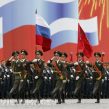
MOSCOW RESUMES MAY PARADES TO DEMONSTRATE MILITARY STRENGTH
Publication: Eurasia Daily Monitor Volume: 5 Issue: 9
By:

Full-scale, Soviet-style military parades – with displays of tanks and other military hardware – will return to Red Square beginning May 9. The decision to resume this public display of military might was reportedly taken at a January 12 meeting of top Russian military leaders. The new Topol-M (SS-27) mobile intercontinental ballistic missiles will also roll past the reviewing stands near the Kremlin wall. The parade is timed to celebrate VE-Day, the end of the European portion of World War II (Interfax, January 15).
The planned high-profile parade will apparently coincide with the inauguration of the next Russian president, presumably Dmitry Medvedev, whom Vladimir Putin has designated as his successor. Medvedev’s election on March 2 is a near certainty, since elections are a mere formality in the framework of Russia’s imitation democracy, and the new president must be inaugurated during the first half of May. A public display of Russian armor and nuclear might is clearly a grand way to welcome Medvedev and to commend Putin, who has agreed to serve alongside Medvedev as prime minister. Its easy to imagine them both – Putin and Medvedev – standing side-by-side atop the reviewing stand in front of Vladimir Lenin’s tomb, as the tanks and ICBMs roll by and jet fighters scream overhead – symbolizing the restoration of mighty Russia, better known in the 20th century as the USSR.
In recent months, the Russian military has repeatedly made high-profile displays in an effort to reclaim its lost glory. Last August Russia resumed regular patrol flights of strategic bombers over the Arctic, Pacific, and Atlantic Oceans. At present, a naval task force of ships from the North and Black Sea Fleets has been assembled in the Mediterranean. The Russian aircraft carrier Admiral Kuznetsov, cruiser Moskva, two frigates, and five support ships will perform exercises in the Mediterranean and afterward, reportedly, sail to the Atlantic to exercise in waters close to U.S. shores (RIA-Novosti, January 14).
The naval task force is the biggest that has been deployed in the Mediterranean or the Atlantic since the collapse of the Soviet Union in 1991. General Vladimir Shamanov, head of the Defense Ministry’s Main Directorate for Combat Training, announced that the dispatch of the Kuznetsov carrier group is part of the Russian response to threats coming from the United States and Washington’s plans to deploy missile-defense components in Poland and the Czech Republic. “Operative and operative-tactical events planned for next year will take place in the context of appropriate measures,” he explained, “taking account of the new realities that others are attempting to create for us in the Western strategic direction, in the form of deploying missile defense elements” (Nezavisimaya gazeta, December 19).
The deployment of the Kuznetsov carrier group to the Mediterranean has been prominently reported by government-controlled TV as confirmation of Russia’s military revival (Channel 1, January 14, 15). At the same time Medvedev, while visiting the Murmansk port area, near the main base of the North Sea fleet, announced, “We must revive the Navy, we need to do this to protect our fishermen and for Russia to be a full-fledged naval power.” At present, however, Medvedev stated, Russian naval ships are not deployed in the Barents and Norwegian Seas, where fishing disputes with Norway often happen, “because the ships don’t exist.” Medvedev added, “When we had normal naval power, ships were there and everyone respected us” (Vedomosti, January 14).
Independent defense analysts agree with Medvedev. Russia still has large stocks of Soviet-made military hardware; most of it fully or partially out of order. Only a handful of ships, tanks, and jets are truly operational at any given time. The naval command managed to put together a carrier group to fly the flag in the Mediterranean, but there is nothing left to show at home in the Barents Sea. In any case, the Kuznetsov task force only pretends to be a regular carrier group. The Kuznetsov carries only a limited number of fighter jets and trainer aircraft, but no attack planes – it cannot project any force on land like Western carriers. After the current voyage, the Kuznetsov will reportedly go into a shipyard for repairs that may last years (Moskovsky novosti, December 15).
The parade itself will reflect the changes of recent years. The last massive Soviet military parade on Red Square with tanks and missiles happened on November 7, 1990. In 1995 military parades on Red Square were resumed to commemorate VE-Day, but without any hardware. The knowledge of how to organize Soviet-style military parades has been essentially lost.
The vicinity of the Kremlin has been rebuilt. A large semi-underground mall and the restored Resurrection gates with icon of Mother Mary now block the customary Soviet approach route of tanks and ICBMs into Red Square through Manezh Square. The task of reviving defense hardware parades on Red Square will face grave technical and logistical problems and in any event will most likely produce only a pathetic imitation of Soviet military grandeur – the same as the Kuznetsov dispatch to the Mediterranean.
One can only hope that Russia’s aged ships and the crew on board will all safely return to base after the long voyage and that no ancient building will collapse as tanks and ICBMs roll into central Moscow to serve the vanity of Russia’s leaders.




